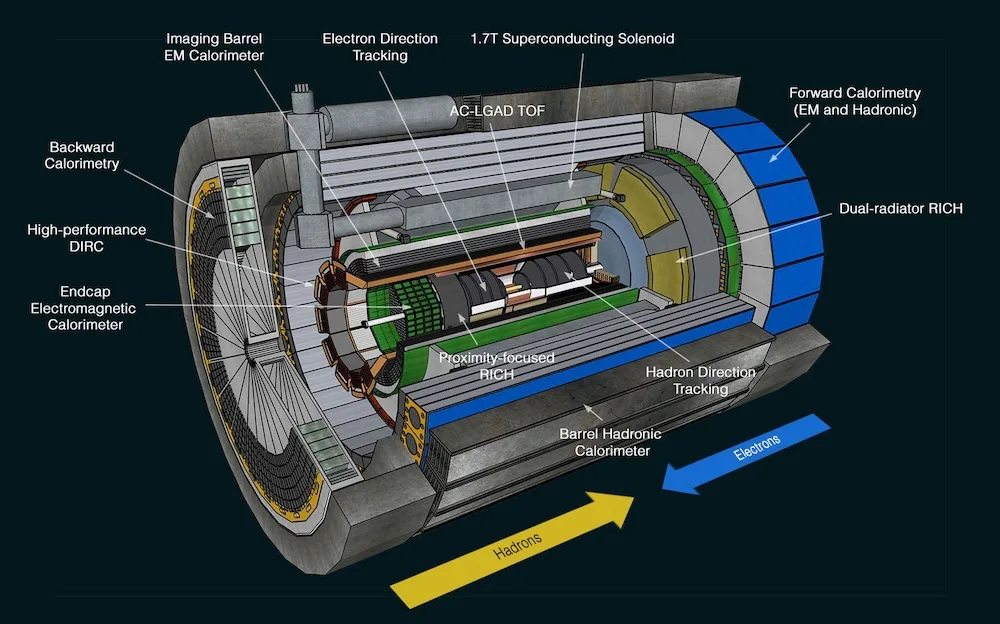Everything from the depths of the earth to the center of the sun and beyond is made up of a jumble of atoms. The matter and energy all in some way connect to form the reality around us. At Brookhaven National Lab (BNL), there is a project underway that will probe deep inside the smallest bits of matter imaginable, beyond even their building blocks to deconstruct the things that make up the things that make up the things in our world.
The planned Electron-Ion Collider (EIC) at BNL will probe the building blocks of electrons and protons, which are themselves building blocks of the nucleus of the atom, to explore how the particles’ internal structure—and the gluelike force that holds them together – build up nearly all visible matter in the Universe.
To explore this frontier (one that unlike Star Trek is not outer space but the inner space of an atomic nuclei) the EIC will smash together electrons with high energy at “a rate of 1 × 1034 per square centimetre per second,” according to BNL. “Lots of collisions (also referred to as high luminosity) means lots of data.”
Officially the EIC is a high-intensity, high-energy electron-ion collider with controlled spin orientation of particles in its colliding beams.
Using the existing tunnel of the Relativistic Heavy Ion Collider, currently operating at BNL, a team of physicists, technicians, engineers, and other professionals from BNL and collaborating partners from around the world, is now working to make the EIC a reality.
And this high-energy, high-luminosity collider requires sensitive equipment to detect the collisions.
“Scientists around the world are also working to design detector systems that will make the most of the EIC’s technical capabilities,” according to BNL.
The EIC will be one of the world’s most complex accelerator projects ever designed and operated. The cost of construction is over $2 billion. New York State announced it secured $100 million for the project. The plan is for the EIC to be operational sometime in the 2030s.
BNL outlined the results of the science that will come out of the EIC:
Such a concentrated effort to design and develop new technologies will likely spark innovations that have impacts well beyond the field of nuclear physics. Cancer therapy is one example. The particle-beam-related improvements for the EIC could lead to improved delivery and quality of particle beams used to treat cancer with reduced cost and improved efficiency and efficacy.
Another potential impact could be improvements to accelerators used in industry – for example, to test computer chips, study new materials for batteries and solar cells, and develop alternative and clean energy technologies. These improvements would also benefit the biomedical industry, where accelerators are used to study different kinds of proteins, including for drug and vaccine development, and for inspecting and keeping our food supply safe.
The research and development (R&D) anticipated for Electron-Ion Collider detector components will also push the evolution of technologies and bring in new ideas that could be directly exported for use in security operations, for example to identify illicit drugs in closed cargo containers or to identify other national security (sensitive) materials.
In addition, the EIC’s need for highly efficient data collection, storage, and analysis will spark advances in computing that extend to other fields, including finance, climate modelling, and other data-intensive challenges.
Finally, and perhaps most importantly, by attracting the best science, technology, engineering, and mathematics (STEM) workforce from around the world to build and run the EIC, we will be building up a tech-savvy workforce for tomorrow while also building bridges that connect nations of the world.
“The tools, technologies, and connections they develop will benefit mankind for many decades to come,” says BNL.
Photo: Schematic of the ePIC detector being designed to capture details of particle collisions at the future Electron-Ion Collider (EIC). (ePIC Collaboration)




